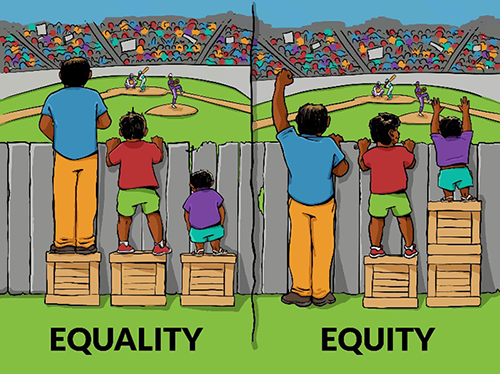Equality and equity
How can I ensure the right balance of remote working across the team?
Having an oversight of each team member’s Dynamic Working arrangements will be important to enable managers to maintain fairness and consistency. Before moving to implementation, managers should speak to each individual to understand their preferences so that they can be considered in an equitable way. Equity does not necessarily mean treating everyone the same as illustrated by the graphic below

Image description: A graphic illustration showing two scenes. On the left are three people standing behind a fence watching a baseball match, they are all on equal size boxes, but each person is of different heights so only two can see over the fence. Below this illustration is the word 'Equality'. On the right, three people stand behind a fence but this time, the tallest person has no box while the shortest person has two. All three can now see over the fence. Below this illustration is the word 'Equity'.
Image credit: Interaction Institute for Social Change | Artist: Angus Maguire.
Hot desking might not be appropriate for employees with a disability – how do we handle this?
Hot-desking could impact on employees with disabilities in different ways. For example, an employee with a hidden disability such as Irritable Bowel Syndrome (IBS) may need a desk close to toilet facilities. A neurodivergent employee may be overwhelmingly anxious not knowing where they will be sitting when they come in or require their workstation to be set up in a specific way to work most effectively. A partially sighted employee may require specific equipment on their desk.
The best place to start is for managers to ask their team member, as they are the expert in their own disability. It may be that managers can make any specific or supporting equipment required available at several hot desks or it may be more appropriate to assign them a dedicated desk (which may be shared by others on days when they are not in the office).
Could Dynamic Working support someone with a disability to manage their condition more effectively from their own health perspective and work perspective?
Feedback from members of the Staff Inclusivity Group and feedback received through the all-staff survey indicated that many staff with disabilities (both declared and undeclared) have found working dynamically to be beneficial to manage symptoms of their conditions which might sometimes have prevented them coming into the office. This has helped to improve wellbeing, inclusion and productivity for numerous colleagues who manage condition(s) that have a substantial and long-term impact on their ability to do normal day to day activities, which may or may not be known to their managers and/or other colleagues. Several members of the Staff Inclusivity Group have written blog posts addressing this topic: Living with an invisible condition and What it's like to be deaf in a global pandemic.